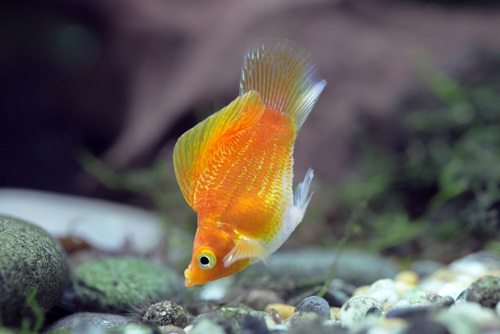
When setting up a community tank it is natural that you want everything to go along smoothly. You may have wondered ‘Are Molly Fish Aggressive or Friendly’ after hearing mixed reports about their behavior. In truth, these are friendly fish, but as with any species, it’s always best to fully understand them fully.
This guide will answer the common question ‘Are Molly Fish Friendly’ and show you how aggression may arise in circumstances of competition or stress, what you can do about it, and how to set up a peaceful community tank with Molly Fish – so read on.
Are Molly Fish Aggressive Or Friendly?
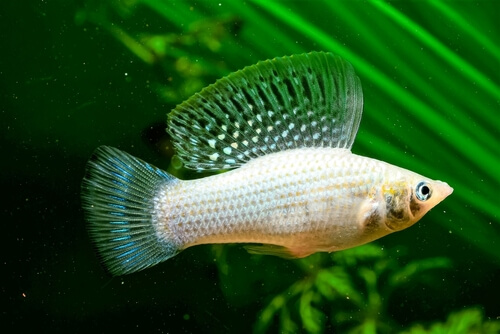
Molly Fish differ from other species in that they are live-bearers, meaning they give birth to live young. You may find yourself asking ‘Are Molly Fish aggressive or friendly?’ after this, and wondering what other unique requirements they have.
In pet shops, you may even see them kept alongside other species like Platies, Guppies, and Swordtails. This is just one example of how Molly Fish are a friendly and peaceful species, but like with any fish, aggression can happen over food, mates, or living space.
Are Mollies Aggressive Over Territory?
Are Molly Fish aggressive over territory or food? If you have seen Molly Fish kept in an overcrowded tank, you will often see them chasing each other or vying for territory. However, given enough space, Molly Fish should not be aggressive at all. In fact, they are actually very friendly and as a result, are recommended as a tankmate for many other tropical freshwater species. However, they do need a tank of a minimum of 30 US Gallons or 114 liters.
What Makes Molly Fish So Friendly?
So, it is established that Mollies are a friendly species without any inherent aggression compared to hierarchical species like Angelfish. But what makes these guys so friendly?
As live-breeding fish, Mollies are often trying to win a mate. This means they are social fish, and these social shoal dynamics mean they prefer the company of other fish. They are not solitary or territorial at all, unlike species such as Betta Fish – although they can act as good Betta tankmates if other conditions are right.
However, once in a familiar group, other factors can lead to Mollies becoming more aggressive than they would be with unfamiliar fish. In the end, like with any community tank, you will quickly get to know the dynamics of your individual group of fish and what is and is not normal behavior for them.
In addition, as small fish that are often prey in the wild, Mollies prefer safety in numbers and are happiest hanging out in groups of six plus. This means that they have evolved to tolerate the presence of other fish, and indeed, they even require this.
Author’s Note: As social fish, Mollies’ group behavior is complex. There are many things scientists still do not know about their social relationships. However, one thing is certain, which is that your Mollies need others of their own species to truly thrive.
What Tankmates Are Molly Fish Compatible With?
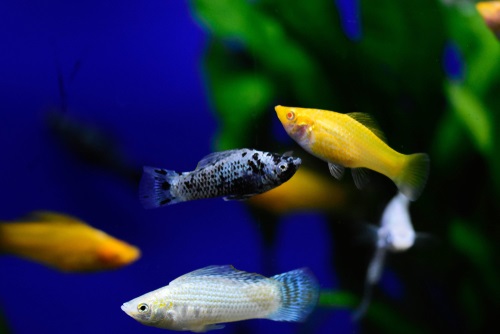
Once knowing these are friendly fish, don’t be too fast to integrate them into a community tank, like any fish, there are tankmates that they are and aren’t compatible with.
The biggest concern is that Molly Fish can become prey for larger fish like Cichlids. The exceptions are Angelfish and Discuss Fish, which are too small to feed on Mollies and can be suitable tankmates if all other conditions are met.
Mollies also don’t get on well with coldwater species like Goldfish, simply because the water temperatures are incompatible.
Molly tankmates are otherwise very varied. The following list will give you a good idea of which fish they can get on with – although remember, other conditions like tank size and correct food must be met. This list does not imply these fish have the same needs at all, only that they generally will not trouble each other if kept together.
Best Compatible Molly Fish Tankmates:
- Angelfish
- Discuss fish
- Swordtails
- Chinese Algae Eater
- Platies
- Rasboras
- Tetras
- Pleco Fish
- Small loaches such as the Kuhli Loach
- Swordtails
- Platies
- Guppies
- Smaller Cichlids such as the Electric Blue Ram Cichlid
Are Molly Fish Friendly To All Other Species?
Yes, generally Molly Fish are friendly to most other species. There is only one exception, and even then, this is not a common occurrence, but aggression in the form of fin nipping may occur towards similar, closely related fish like guppies, as male Mollies may see these as competition for mates.
Author’s Note: This is also easily solved by having the correct sex ratio and giving your fish enough space. It is far more likely that Mollies, as peaceful fish, can be on the receiving end of aggression from larger species, especially cichlids, so choose these carefully.
What Are Some Circumstances In Which Molly Fish May Show Aggression?
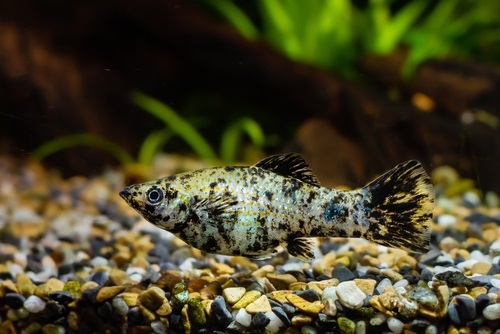
As Molly Fish are so friendly to other species, you may be forgiven for thinking that they are also this friendly to their own kind. And yes, Mollies are adapted to coexist in schools. But when it comes to breeding, things are sometimes different, so read on to understand when and why Mollies might show aggression.
Lack Of Space
It may seem obvious, but any fish that is given unsuitable conditions that are too small will show aggression as fish will feel threatened due to competing for territory and food. Mollies can grow surprisingly large, up to around 4 inches or 10 cm.
Mollies need to be kept in groups of five or 6 and for a group this size a tank of ideally 30 gallons or 114 liters at minimum is needed for them to properly thrive.
Author’s Note: When planting your tank you can create separate territories by spacing plants in groups, providing pathways and hideaways, and adding driftwood and rocks to break up the area.
Breeding
Breeding is one of the occasions that Molly Fish can and do show aggression to their own species. These fish are prolific breeders and often males will harass females into breeding with them. This is called ‘sneak’ courtship and is a strategy of smaller and less sexually desirable males. In fact, it can sometimes happen even when a female Molly is already pregnant.
Even if not overtly aggressive, this can be intimidating and stressful for your female Mollies. As a result, you should add a sex ratio so that there are one or two males for every three to four females. That means no one female gets harassed too much.
Are Mollies Aggressive Fish When Breeding?
Apart from this, Mollies are not seriously aggressive when breeding, unlike bettas, although they can show some behavior that looks aggressive. The actual native process can look like chasing, and thus you may worry that your fish are being aggressive. In addition, fish may chase each other simply as a form of play.
How To Deal With Aggression In Molly Fish
The best way of dealing with aggression in Molly Fish is to find the cause and remove it. Generally, this is caused by an imbalanced sex ratio, poor water conditions, or a lack of space. In the latter case or the first case, you may have to find a bigger tank or add more fish respectively.
Author’s Note: Sometimes fish aggression can break out just because fish are stressed due to dirty water. Always remember to clean your Molly tank once a week, replacing about a third of the water with fresh by removing it with an aquarium vacuum and pouring in clean filtered water of the same temperature.
Ensuring Your Molly Fish Remain Friendly
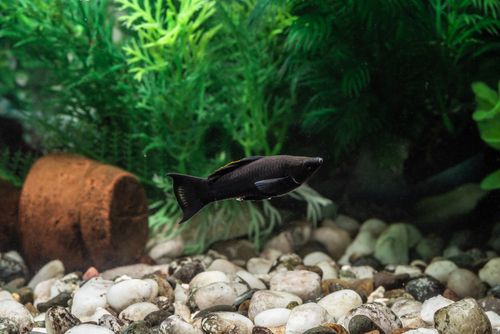
Although they are generally peaceable naturally you want to ensure your Molly Fish group remains calm and friendly. To do this, simply ensure you meet all Molly Fish care requirements and they get the best conditions possible:
Feed Them Regularly
Always feed your fish regularly! It goes without saying, but fish that lack food are more likely to become aggressive and fight over food when you do provide it.
Mollies are omnivores and tropical fish pellets or flakes can work as basic food, but they always enjoy you enriching their diet with fresh or frozen protein like bloodworms, brine shrimp, and daphnia.
Keep The Tank Clean
Keeping the tank clean ensures Molly Fish won’t get stressed or susceptible to disease. If a fish is in pain or feels threatened it may become aggressive.
Use A Large Enough Tank
Overcrowding is a very common cause of aggression in Molly Fish. In addition, it can exacerbate the pre-existing behaviors male Molly Fish have of chasing females. This is because, in close proximity, there is very little opportunity for the female Mollies to get away.
Thus, a large enough tank is crucial for providing a harmonious balance.
Provide Different Territories
In addition, if fish are being picked on or bullied by more aggressive tankmates, one way of managing this is to provide them with hiding spots or divided territories in the tank. This is not just a solution but can also be a preventative measure.
Different territories mean your fish will not feel the need to fight each other. They also provide spaces for shy fish or pregnant females.
Bottom Line
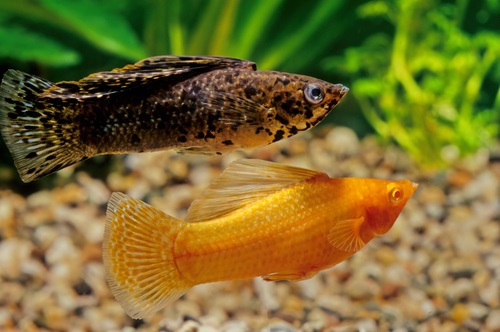
You should rarely have aggression issues with this friendly fish, which makes a great tankmate for a huge variety of popular aquarium fish species. However, if aggression does break out, hopefully, this guide will break down why and what you can do about it.
Remember, getting conditions right is three-quarters of the answer. Any fish, when kept in the right environment, will show calmer and more natural behavior than those that are not – so take care of your fish, and they will reward you for it.




